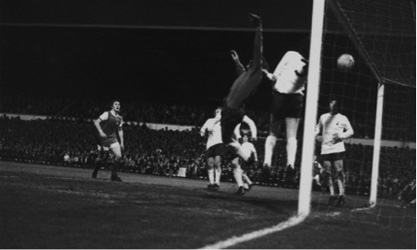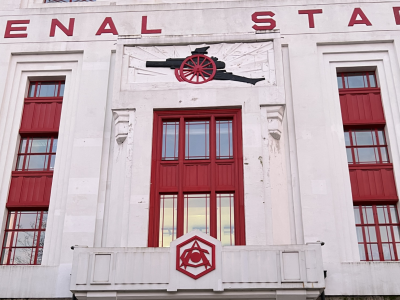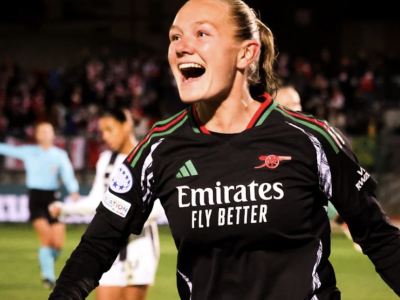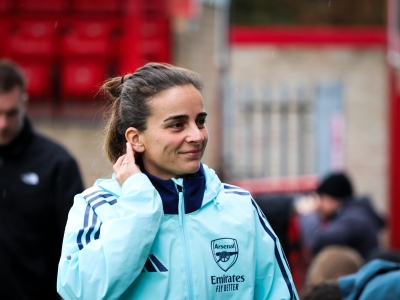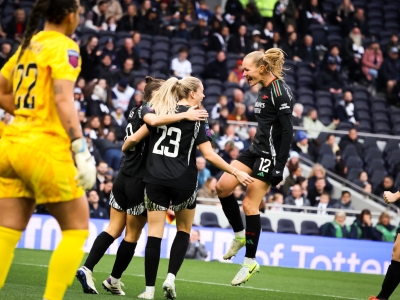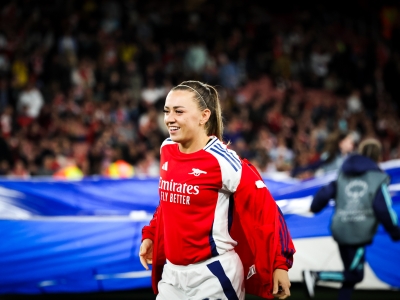Arsenal’s first away game at Tottenham Hotspur dates back to February 1897, in a United League fixture which took place at Northumberland Park in front of just 2000 people, which ended in a 2-2 draw. Woolwich Arsenal, as they then were known as, played Tottenham three times at Northumberland Park drawing two and losing one. Tottenham Hotspur moved to the Stadium known as ‘White Hart Lane’ in 1899, though none of the four roads which surround the ground are actually called White Hart Lane.
The name seems to have stuck because the nearest train station to the ground is called White Hart Lane. The actual road itself has a Football Ground, which is the home of Haringey Borough FC and is called Coles Park Stadium – a tiny ground which has a capacity of 1500 and funnily enough hasn’t been mooted as a temporary home for Tottenham Hotspur while ‘White Hart Lane’ is being redeveloped. Arsenal’s first visit to Tottenham’s current home came in April 1900, which resulted in a 2-4 defeat for the Gunners. Arsenal’s first away win over Tottenham came with a 1-0 victory in September 1903 in a fixture in the London League.
It’s a little known fact, but during the opening years of the twentieth century Tottenham Hotspur also found sporting success outside of Football, in the sphere of Baseball. In 1888, the Football League was created to produce enough regular fixtures to raise revenue to sustain Professional Football and a visit to the USA the following year by Derby-based industrialist Francis Ley led to foundation of Derby County Baseball Club (whose purpose built ground later became home to Derby County FC hence why it was called the Baseball Ground), as well as the National Baseball League of Great Britain and Ireland. This had been a four team tournament involving sides created by Aston Villa, Preston North End and Stoke City.
Baseball became a way of Football clubs generating revenue during the summer months, as well as keeping players fit and employed during the summer months (Derby’s England international striker Steve Bloomer being as prolific at Baseball as he was at Football). The National Baseball League of Great Britain and Ireland lasted until the end of the nineteenth century with Middlesbrough and Nottingham Forest also winning titles. After a seven year hiatus, the British Baseball Association (BBA) had been founded in 1906. That year, a Woolwich Arsenal’s Directors’ Report stated that: ‘the Directors have long felt that your football ground should be utilized as far as possible during the "close season," and an endeavour is being made this summer, in conjunction with other football clubs in London, to introduce the game of baseball as a summer attraction’.
Though considered a National Championship, the BBA was a mostly London-centric affair involving Millwall, Brentford, Crystal Palace, Tottenham Hotspur, Leyton Orient (then known as Clapton Orient), Fulham, Leyton, West Ham, Chelsea as well as Arsenal. In the first year of the BBA, Tottenham Hotspur attracted 2,500 fans at White Hart Lane as Spurs won the National Championship, as well as winning the title again two years later in 1909, before the competition folded in 1911. Spurs have been National Baseball Champions as often as they have been National Football champions and should Spurs win the title this season it would be the first time in their history in which they have had more Football titles than Baseball titles.
Back on the football side of things, Arsenal’s first away League meeting with Spurs came in April 1910 and ended in a 1-1 draw. Arsenal moved to Highbury in 1913 and on the outbreak of the First World War a year later, White Hart Lane was commandeered by the British government and used as a factory for the production of gas masks. As a result Tottenham played home games at Highbury between 1916 and 1919, as well as Clapton Orient’s ground in Homerton. Arsenal’s first away North London Derby came in January 1921, with Spurs returning to the top tier that season, after they dropped out of the old Division One as a result of finishing bottom of the table (as opposed to some great conspiracy, regardless of the circumstances of how Arsenal got promoted).
In the event Spurs inflicted a 1-2 defeat on the Gunners. Arsenal’s first away League victory came in September 1922 with a 2-1 win for the Gunners secured by two goals for Reg Boreham. The match was a controversial affair which led to both sides being charged with bringing the game into disrepute and is told in greater detail here on Andy Kelly’s Arsenal history blog. Arsenal’s first visit to Tottenham under the management of former Spur Herbert Chapman came on 2nd January 1926 with the Gunners leading the old First Division. The game ended in a 1-1 draw. Chapman’s first win over Spurs as the Arsenal manager came in May 1927 with a thumping 4-0 away win secured by two goals apiece for Jimmy Brain and Reg Tricker.
The following season however, Spurs inflicted a 0-2 defeat on Arsenal in April which took them to eighth in the table and six places above Arsenal in fourteenth with just four games left to play. Incredibly, Spurs lost three of their last four games, finishing second from bottom and dropping into the second tier at the end of 1927/28, while Arsenal finished eleven places above them in tenth place but with only three points more than Tottenham and in fact drew five of their last six games. Spurs spent five years in the second tier before returning as second tier runners up, one point behind Stoke City.
Tottenham’s first season back saw them vying with Arsenal for the top spot when Arsenal visited White Hart Lane in September 1933. William Felton gave Spurs the lead from the penalty spot, while Arsenal equalised with a goal from Ray Bowden, the match ending in a 1-1 draw. Tottenham finished third place behind Champions Arsenal, however lasted just one further year in the top flight, finishing rock bottom of the table in 1934/35 while Arsenal won the title again, on route winning 6-0 at White Hart Lane in early March with goals from Peter Dougall, a Cliff Bastin penalty, as well as two goals apiece for Ted Drake and Alf Kirchen.
It would be another fifteen years before Arsenal would play another League fixture away at Tottenham, though the requisitioning of Highbury as an Air Raid Petrol centre meant that Arsenal were to play their home fixtures at White Hart Lane, the first such fixture six weeks into the war being an 8-4 victory over Charlton in the Football League South. One rare example of where both North London sides would be playing a home game would be a League War Cup fourth round tie which Arsenal would win 2-1. Arsenal and Spurs played each other twenty times during the duration of the war, with Arsenal winning seven times to Tottenham’s six, with six games drawn.
Arsenal ended up playing a total of 133 home fixtures at White Hart Lane before returning to a bomb damaged Highbury in 1946, the most famous of which would be the friendly game against Moscow Dynamo in late 1945, which Arsenal would lose 3-4. Tottenham would return to the top flight after winning the Second tier title in 1949/50, with Arsenal visiting White Hart Lane two days before Christmas, but losing 0-1. Tottenham’s ‘Push and Run’ side of 1950/51 would win their first league title that season, however in the years which followed would suffer four defeats to Arsenal in a row at White Hart Lane. In February 1952, Arsenal would win 2-1 with goals from Alex Forbes and Don Roper. The following September Arsenal would win 3-1, with goals from Peter Goring, Jimmy Logie and Arthur Milton on their way to winning the 1952/53 title.
In 1953/54 Arsenal would visit Spurs in October and pull of a 4-1 win with goals from Alex Forbes, Arthur Milton and two for Jimmy Logie. After suffering a 1-3 defeat in October 1957, the Gunners would be back to winning ways again at White Hart Lane with a 4-1 win at the end of January 1959, with goals from Vic Groves, David Herd and two for Jackie Henderson. The pendulum however swung back in the direction of Spurs after Arsenal’s visit in January 1960, when the Gunners suffered a 0-3 loss at an icy White Hart Lane with goals from Bobby Smith and two for Clive Allen’s father Les.
In Spurs’s double season of 1960/61, Arsenal visited the Lane in January and suffered a 2-4 defeat with goals from Bobby Smith, a Danny Blanchflower penalty and two for Les Allen, while Joe Haverty and Jackie Henderson were on target for the Gunners. The following August, Spurs made it three home victories in a row over Arsenal with a 3-4 defeat for the Gunners, another goal for Les Allen and a hat-trick for Terry Dyson. On target for Arsenal were Alan Skirton and two for Mel Charles. In 1962/63, Arsenal finally disrupted Spurs’s winning streak on visited White Hart Lane in October with a 4-4 draw, after being 2-4 down. On target for Tottenham had been John White Dave Mackay and two goals for Cliff Jones, while Arsenal’s goals were scored Geoff Strong, Johnny McLeod and two for David Court.
Arsenal were to visit White Hart Lane again three months later in a friendly match, the purpose of which had been to get match practice in after a six week break caused by the ‘Big Freeze’, which resulted in the coldest winter of the twentieth century. Arsenal’s last competitive match had been defeating Leyton Orient 2-0 at Highbury on December 15th. Spurs won the game 3-1 and four days later at Highbury Arsenal finally got to play their FA Cup third round tie with Oxford United. Such was the extent of postponement that winter that some third round ties weren’t resolved until as late as 11th March (that year’s Semi Finals were originally scheduled for 30th March). Twelve months on, Arsenal visited a Spurs side sitting atop of the old First Division and suffered a 1-3 defeat with goals from Jimmy Greaves and two from Cliff Jones, while Geoff Strong was on target for the Gunners.
Making his Tottenham debut in that February 1964 match had been Laurie Brown who had signed for Spurs from Arsenal just the day before! Spurs’s title challenge however collapsed as the 1963/64 season progressed, finishing in fourth place six points behind League Champions Liverpool. Tottenham had by this point finished in the top four for seven seasons out of eight, however tragedy struck in the close season when twenty seven year old midfielder John White had been killed after being struck by lightning while sheltering under a tree during a thunderstorm at Crews Hill Golf Course in Enfield, with his funeral four days later (this blog here written by John White’s son on his father’s career and death is featured on worldsoccer.com.
Two months later, Arsenal visited White Hart Lane for the 1964/65 season and again suffered a 1-3 defeat with Jimmy Greaves, Jimmy Robertson and Frank Saul on target for Spurs, with Joe Baker on target for the Gunners, in what was Geoff Strong’s final game before transferring to Liverpool. In September 1966 Arsenal were to lose 1-3 again at White Hart Lane for the third game out of four, with a 2-2 draw almost exactly twelve months earlier briefly disrupting Tottenham’s winning run (a game in which Arsenal took a two goal lead). Spurs won the FA Cup in 1967 and just ahead of the 1967/68 season played a friendly at Hampden Park against Celtic’s ‘Lisbon Lions’ who became the first British side to win the European Cup that same year, which ended in a 3-3 draw.
An Alan Gilzean goal in January 1968 meant that Arsenal had now gone nine games without win at the Lane, before Arsenal bagged their first win away to Tottenham in nine years with a 2-1 win on the opening day of the 1968/69 season, with John Radford on target as well as a Phil Beal own goal, while Jimmy Greaves scored for Spurs. Arsenal’s first win over Spurs during the 1960s was to be captured by the first ever episode of LWT’s The Big Match, however an industrial dispute prevented the programme from going ahead. Arsenal met Spurs again at the end of the year in the League Cup Semi Final, with Arsenal taking a 1-0 lead from the first leg to White Hart Lane. A 1-1 draw with goals from Jimmy Greaves for Tottenham and John Radford header three minutes from time meant that Arsenal were heading to Wembley for the second year in succession.
Arsenal of course won the Fairs Cup in 1970, however before any claims to a shift in power in North London could be made, a 0-1 defeat the following Saturday on the final game of the season was secured with a goal from Alan Gilzean, nearly one month on from the Gunners previous League game against West Ham on 4th April, as the season had ended early due to preparations for the upcoming Mexico ’70 World Cup, though Arsenal’s Fairs Cup run prevented the Spurs game from going ahead earlier. One year and one day on from this game Arsenal were again to meet Spurs in a rearranged fixture which would decide the fate of the 1971 League Championship, with Arsenal a point behind Leeds United, with the Gunners needing a win to overhaul Leeds or a 0-0 draw to take the title on goal average.
It’s worth remembering that Tottenham that season won their first League Cup so were certainly no push over. 52,000 made their way to White Hart Lane that night, however it was estimated that nearly twice that number were locked out. The highlights of the game also were unable to be shown on television as that same night a fourth tier tie between Southend and Lincoln also took place, as well as the second leg of the Texaco Cup final between Wolves and Heart of Midlothian took place and a corporatist minded Football League in those days didn’t want those attendances effected, which is why the footage is restricted to grainy ITN newsreel.
Such was the traffic that Tottenham’s Steve Perryman had to abandon his vehicle half a mile away and walk to White Hart Lane in order to make the kick off. In the event, Martin Peters hit the crossbar for Spurs and a Frank McLintock shot was cleared off the line. Three minutes from time however Ray Kennedy got on the end of a George Armstrong and headed past Pat Jennings in the Tottenham goal. One goal for Tottenham however would have given the title to Leeds on goal difference and Spurs then laid siege to the Arsenal goal, with a last minute melee in front of the Arsenal goal end but which Bob Wilson grabbed at for safety to give the Gunners a 1-0 win and the first leg of emulating Tottenham’s double of ten years prior, which was completed five days later by winning the FA Cup.

